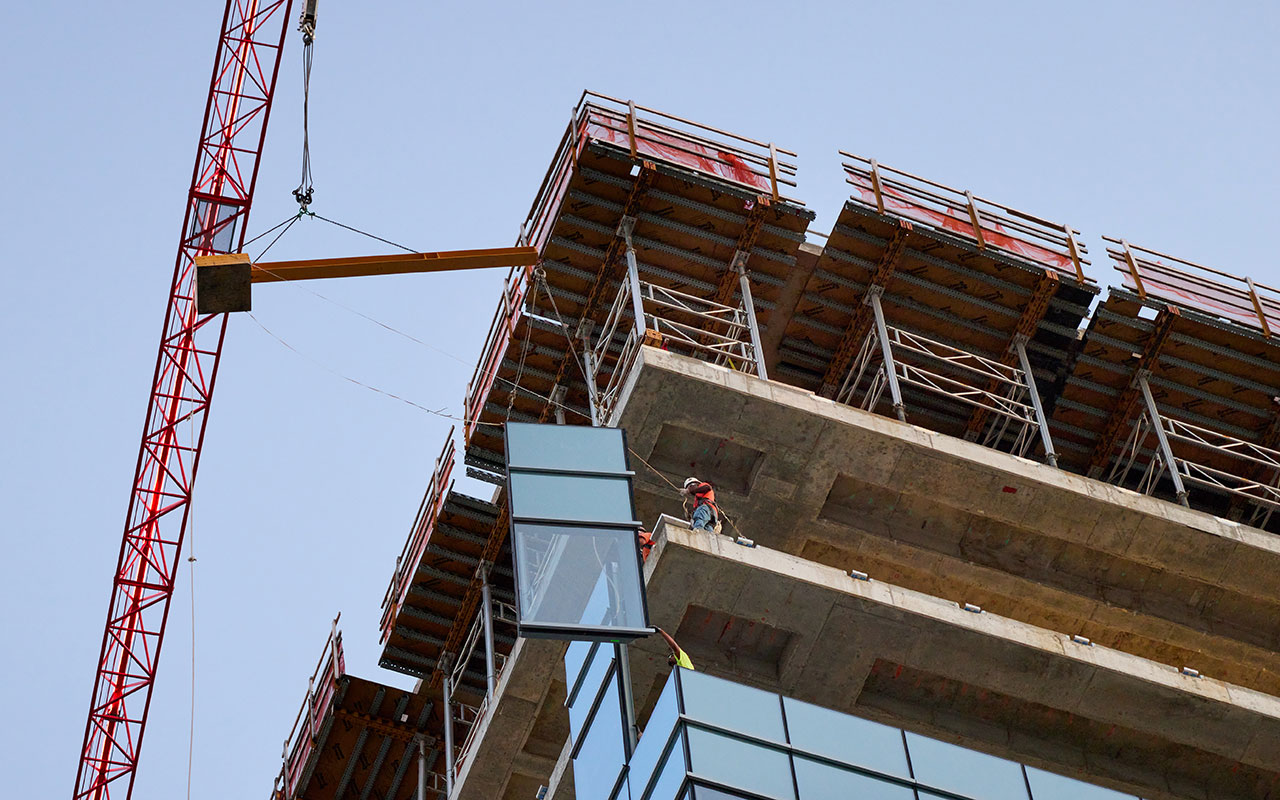The Neuroscience Research Building under construction on the Washington University Medical Campus promises great discoveries in an environmentally friendly building that meets sustainability goals. The completed structure will contain energy-efficient, low-energy research freezers in laboratories; electric charging stations in the parking garage; and numerous other sustainability-focused elements.
The 11-story, 609,000-square-foot building at 4370 Duncan Ave. on the Medical Campus is on track to achieve Leadership in Energy and Environmental Design (LEED) Gold certification. LEED is a green building rating program providing a framework for healthy, highly efficient, less expensive buildings. LEED Gold certification is the next to the highest rating.
“The building design was critical to ensure efficient space use and to reduce energy and the impact on the carbon footprint,” said Melissa Rockwell-Hopkins, associate vice chancellor for operations & facilities management at Washington University School of Medicine in St. Louis. “We recognized early on the importance of reducing the impact of the built footprint on the environment. In the design of this building, we have worked hard to reduce the use of materials, water and electricity while maintaining energy efficiency and without compromising anything needed to support the invaluable research that will occur in the Neuroscience Research Building.”
Researchers use ultra-low temperature (ULT) freezers to store chemicals, enzymes, bacteria and other samples. About a third of the laboratories in the facility will have the most energy-efficient ULT freezers on the market, which use only half the electricity of standard ULT freezers. An average ULT freezer consumes as much energy as a single-family home.
Computer-controlled airflow systems will create a safe and healthy workspace and reduce energy use in the building, said Rockwell-Hopkins, also the associate dean for operations and facilities. In addition, for the first time on the Medical Campus, a research building will include all LED (light emitting diode) light fixtures, noted for their energy efficiency. Also, limiting water usage in the facility will be low-flow showers on the first floor for employees who ride their bikes to work; low-flow toilets and faucets throughout the building; and settings on high-performance laboratory equipment that reduce water use.
Employees tend to work best in a quiet environment, so sustainability efforts also will focus on reducing building noise. For example, new specifications on door seals and wall construction will limit sound reverberation from mechanical equipment in the building. In addition, noise-attenuating materials for interior walls and doors will decrease the transmission of voices from adjacent spaces.
“Sound-related complaints are the No. 1 complaint of building occupants,” said Shana Scheiber, building performance consultant at Affiliated Engineers Inc. and the building’s LEED expert. She consulted on issues to improve the building’s LEED rating. “In a concert hall, you want to feel the sound. That is not the case in a research lab. So we want to limit sound transmission in a building like this — people want to be able to have private conversations.”
A coffee shop on the third floor will connect to a large rooftop terrace that can be used as a gathering place for employees and as an event space. Umbrellas and trees, such as elms, junipers, and magnolias, will generate shade to help reduce heat produced by buildings in urban areas during hotter months. Such heat contributes to higher daytime temperatures, less nighttime cooling and more air pollution.

Millions of birds die in the United States each year after crashing into buildings, especially structures with extensive glass surfaces. Buildings in St. Louis, at the confluence of the Mississippi and Missouri rivers, pose even more of a problem to birds because the area is one of America’s most active flyways for annual north and south migration.
During the design of the Neuroscience Research Building, Rockwell-Hopkins and other members of the building project team were pleased to learn through meetings with Anne Tieber, curator of birds at the Saint Louis Zoo, that elements incorporated into the building’s design would help minimize the risk of bird deaths. For example, metal panels and ribbon windows — windows that form a horizontal band across a building, breaking up its façade — are expected to help discourage bird strikes.
Preventive strategies also are being employed regarding chemicals within the building. The Healthier Hospitals Initiative, a national effort that encourages eliminating chemicals, antimicrobials and flame retardants in health care, guided the selection of furniture and interior finishes. The goal of this initiative is to avoid harmful chemicals that can exacerbate health problems and to identify alternatives manufacturers can choose instead.
Further, the 1,850-car parking garage is on track to receive Parksmart certification based on a rating system designed to advance low-emission transportation through innovative parking design and operation. In addition to 36 electric vehicle charging stations, the parking garage will house 100 covered bicycle racks and a bicycle fix-it station.
See here for more information on the construction of the Neuroscience Research Building.
Source: Read Full Article



